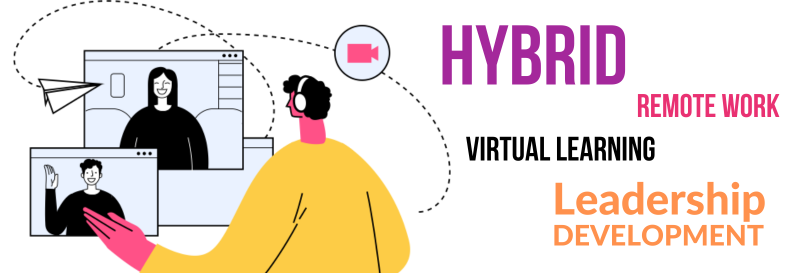
Leadership Development in the Time of Remote Work & Learning
Harnessing the Power of Remote Work and Virtual Learning for Leadership Development
Dhruti Shah, Director, C2C Organizational Development
Jun 29, 2023
Growth of Remote Work and Virtual Learning
The pandemic made remote work and virtual learning necessary, but it only accelerated a trend that already existed.
Now, the remote aspect of workplaces is set to be a lasting fixture. According to a 2022 Mckinsey report, 87% of the 25,000 survey respondents said that they would take remote/hybrid work options if offered.
Many employers and leaders have expressed concerns that the rise of remote work would hamper productivity, but this doesn’t seem to be the case. A Stanford Study of 16,000 workers over a period of 9 months found that productivity actually increased by 13%. This Forbes article also shares several tentative data points that suggest remote work is, at the very least, not a hindrance to productivity.
As a consultant and coach, I am aware that these data points are not universally applicable, but there is a shifting trend that none of us can ignore, just like generative artificial intelligence. It’s here, and now the only thing that we need to figure out is how to make it work for us.
This brings me to the world of virtual learning.
Virtual learning has risen in popularity with more equitable access to suitable technology alongside the rise of remote work. Several tools like Zoom, Teams, Slack, Miro have ensured that collaboration and productivity do not take a huge hit in virtual learning.
Depending on your workplace and your personal learning needs, each platform has various pros and cons to consider. I would suggest playing around and experimenting with each platform’s functionality before committing to using one over another for your virtual learning sessions.
Benefits of Virtual Learning in the Corporate World
As a facilitator, I’ve always been excited about the possibilities for new ways to learn and help my participants. That’s why I’ve always taken a keen interest in the latest technologies related to leadership development in the workplace. It’s clear to me that the rise of virtual learning is a net positive for the corporate world.
Let’s look at five main benefits:
- Increased accessibility and flexibility -Virtual learning eliminates geographical barriers, enabling employees to access resources wherever they are, whenever they want.
- Cost-effectiveness - Virtual learning is kinder to HR budgets. Organizations and employers save on travel and facility expenses for expansive learning events. Returning to my garden metaphors, it’s like cultivating beautiful plants without spending funds on fancy fertilizers or expensive compost.
- Broader range of learning resources and experts - Virtual learning enables access to global expertise and diverse learning materials. You have a breadth of knowledge sources at your fingertips, each bringing unique sets of skills.
- Customizable learning experiences - You can tailor learning programs to individual needs, much like customizing the perfect blend of soil, water, and nutrients for each plant.
- Enhanced collaboration and engagement - Interactive tools and features, like digital whiteboards and breakout rooms, encourage active participation while also offering the possibilities for enhanced, specialized feedback.
Yet, while all that sounds fantastic, and while I’m certainly a virtual learning enthusiast, I’m still aware there are challenges to overcome.
Challenges and Considerations in Virtual Learning
When engaged in learning, there is a lot that’s going on in the moment and, as a facilitator, we need to be tuned in to the micro-signals that we receive from the learners in the room. A true facilitator will pivot the discussion based on these micro and sometimes not to so micro-signals. We lose part of that advantage with virtual learning, since most times, we are coaxing our learners to turn the cameras on. Not seeing their facial expressions can significantly impact the experience.
Here are some other challenges that we face:
Ensuring effective application of learning - Virtual learning must incorporate practical exercises and opportunities for post-learning support. Ensure tangible outcomes to encourage accountability for all stakeholders.
Maintaining employee motivation and engagement - Encouraging active participation and offering incentives are crucial to virtual learning success. A lot of thought needs to go into ensuring that employees enjoy the experience and want to return for more. The notion of showing up as lip service to learning is the enemy of meaningful development.
Addressing technical difficulties and connectivity issues - Providing technical support and stable connections is vital. The whole endeavor is undermined if employees don’t have equitable access to decent software and the required tech.
Adapting to diverse learning styles - Offering various learning formats and encouraging self-directed learning is essential to a valuable learning experience. Great gardeners know they must adapt gardening techniques to suit different plant species and individual preferences. It’s no different for your virtual learning experiences.
Final Thoughts
By embracing virtual learning and nurturing a culture of cohesiveness and collaboration, we can unlock the full potential of remote work and contribute to the long-term success of our organizations.
One way to address a huge challenge of virtual learning is by contracting right with the client. Creating learning journeys that are engaging and tickle the curiosity of learners is key.
Virtual learning is here to stay, and the onus is on all of us (as leaders, team members and facilitators) to leverage the resources to make it successful and impactful. Are we choosing to stare at the limitations or do we intend to take control of the situation and act?
Dhruti Shah is an Organizational Development Consultant and a results-oriented coach who believes in the power of cultivating the right mindset. She has a proven ability to thrive in dynamically changing environments, making her insights invaluable to today’s entrepreneurs and leaders. Dhruti is the author of ‘The Resilient Entrepreneur: Strategies to set you up for success’ – check her book out here.
References:
https://www.sciencedaily.com/releases/2020/09/200902152130.htm
https://www.businessnewsdaily.com/8156-future-of-remote-work.html
https://www.mckinsey.com/industries/real-estate/our-insights/americans-are-embracing-flexible-work-and-they-want-more-of-it
https://nbloom.people.stanford.edu/sites/g/files/sbiybj4746/f/wfh.pdf
https://www.forbes.com/sites/glebtsipursky/2022/11/03/workers-are-less-productive-working-remotely-at-least-thats-what-their-bosses-think/?sh=743c3ad1286a
